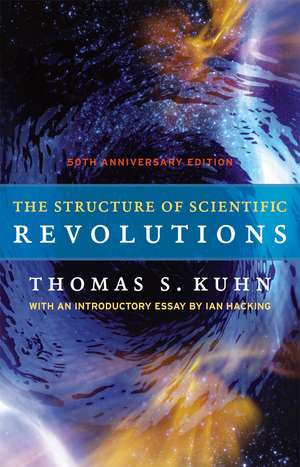The Structure of Scientific Revolutions: 50th Anniversary Edition
Autor Thomas S. Kuhn Introducere de Ian Hackingen Limba Engleză Hardback – 30 apr 2012
A good book may have the power to change the way we see the world, but a great book actually becomes part of our daily consciousness, pervading our thinking to the point that we take it for granted, and we forget how provocative and challenging its ideas once were—and still are. The Structure of Scientific Revolutions is that kind of book. When it was first published in 1962, it was a landmark event in the history and philosophy of science. Fifty years later, it still has many lessons to teach.
With The Structure of Scientific Revolutions, Kuhn challenged long-standing linear notions of scientific progress, arguing that transformative ideas don’t arise from the day-to-day, gradual process of experimentation and data accumulation but that the revolutions in science, those breakthrough moments that disrupt accepted thinking and offer unanticipated ideas, occur outside of “normal science,” as he called it. Though Kuhn was writing when physics ruled the sciences, his ideas on how scientific revolutions bring order to the anomalies that amass over time in research experiments are still instructive in our biotech age.
This new edition of Kuhn’s essential work in the history of science includes an insightful introduction by Ian Hacking, which clarifies terms popularized by Kuhn, including paradigm and incommensurability, and applies Kuhn’s ideas to the science of today. Usefully keyed to the separate sections of the book, Hacking’s introduction provides important background information as well as a contemporary context. Newly designed, with an expanded index, this edition will be eagerly welcomed by the next generation of readers seeking to understand the history of our perspectives on science.
With The Structure of Scientific Revolutions, Kuhn challenged long-standing linear notions of scientific progress, arguing that transformative ideas don’t arise from the day-to-day, gradual process of experimentation and data accumulation but that the revolutions in science, those breakthrough moments that disrupt accepted thinking and offer unanticipated ideas, occur outside of “normal science,” as he called it. Though Kuhn was writing when physics ruled the sciences, his ideas on how scientific revolutions bring order to the anomalies that amass over time in research experiments are still instructive in our biotech age.
This new edition of Kuhn’s essential work in the history of science includes an insightful introduction by Ian Hacking, which clarifies terms popularized by Kuhn, including paradigm and incommensurability, and applies Kuhn’s ideas to the science of today. Usefully keyed to the separate sections of the book, Hacking’s introduction provides important background information as well as a contemporary context. Newly designed, with an expanded index, this edition will be eagerly welcomed by the next generation of readers seeking to understand the history of our perspectives on science.
| Toate formatele și edițiile | Preț | Express |
|---|---|---|
| Paperback (1) | 101.24 lei 3-5 săpt. | +30.63 lei 6-12 zile |
| University of Chicago Press – 30 apr 2012 | 101.24 lei 3-5 săpt. | +30.63 lei 6-12 zile |
| Hardback (1) | 326.68 lei 3-5 săpt. | +23.13 lei 6-12 zile |
| University of Chicago Press – 30 apr 2012 | 326.68 lei 3-5 săpt. | +23.13 lei 6-12 zile |
Preț: 326.68 lei
Nou
Puncte Express: 490
Preț estimativ în valută:
62.51€ • 66.85$ • 52.12£
62.51€ • 66.85$ • 52.12£
Carte disponibilă
Livrare economică 28 martie-11 aprilie
Livrare express 13-19 martie pentru 33.12 lei
Preluare comenzi: 021 569.72.76
Specificații
ISBN-13: 9780226458113
ISBN-10: 0226458113
Pagini: 264
Dimensiuni: 140 x 216 x 30 mm
Greutate: 0.47 kg
Ediția:Fourth Edition
Editura: University of Chicago Press
Colecția University of Chicago Press
ISBN-10: 0226458113
Pagini: 264
Dimensiuni: 140 x 216 x 30 mm
Greutate: 0.47 kg
Ediția:Fourth Edition
Editura: University of Chicago Press
Colecția University of Chicago Press
Notă biografică
Thomas S. Kuhn (1922–96) was the Laurence Rockefeller Professor of linguistics and philosophy at the Massachusetts Institute of Technology. His books include The Essential Tension; Black-Body Theory and the Quantum Discontinuity, 1894–1912; and The Copernican Revolution.
Cuprins
Introductory Essay by Ian Hacking
Preface
I. Introduction: A Role for History
II. The Route to Normal Science
III. The Nature of Normal Science
IV. Normal Science as Puzzle-solving
V. The Priority of Paradigms
VI. Anomaly and the Emergence of Scientific Revolutions
VII. Crisis and the Emergence of Scientific Theories
VIII. The Response to Crisis
IX. The Nature and Necessity of Scientific Revolutions
X. Revolutions as Changes of World View
XI. The Invisibility of Revolutions
XII. The Resolution of Revolutions
XIII. Progress through Revolutions
Postscript-1969
Index
Recenzii
“Like Thomas Kuhn, Ian Hacking has a gift for clear exposition. His introduction provides a helpful guide to some of the thornier philosophical issues. . . . We may still admire Kuhn’s dexterity in broaching challenging ideas with a fascinating mix of examples from psychology, history, philosophy, and beyond. We need hardly agree with each of Kuhn’s propositions to enjoy—and benefit from—this classic book.”
"The Structure of Scientific Revolutions did a gestalt flip on just about every assumption about the who, how, and what of scientific progress. . . . The book still vibrates our culture’s walls like a trumpet call. History of science may not have become exactly what Kuhn thought it should, but The Structure of Scientific Revolutions knocked it off its existing tracks.”
“So long as there are still paradigms among us, the achievements of Thomas Kuhn will be remembered.”
“One of the most influential books of the 20th century. . . . Singlehandedly changed the way we think about mankind’s most organized attempt to understand the world.”
“The Kuhnian image of science has reshaped our understanding of the scientific enterprise and human inquiry in general. If you haven’t already read The Structure of Scientific Revolutions, the publication of this inexpensive 50th-anniversary edition offers a perfect excuse to do so.”
























